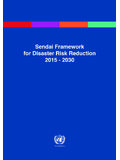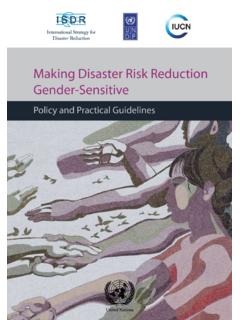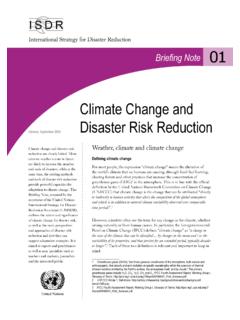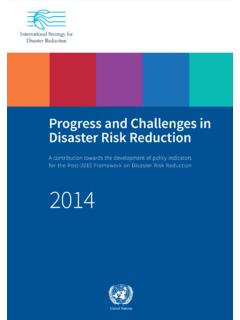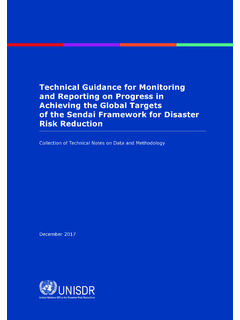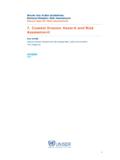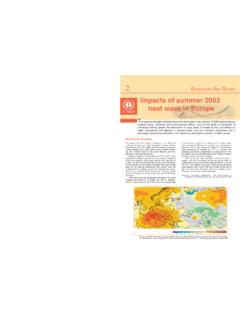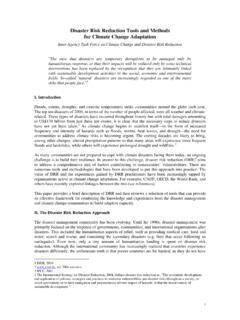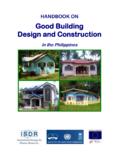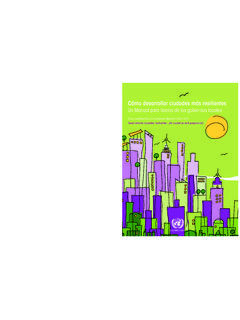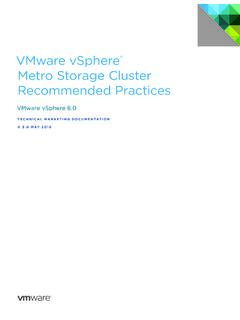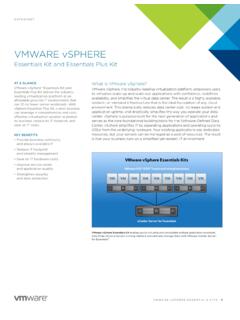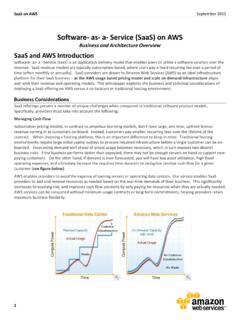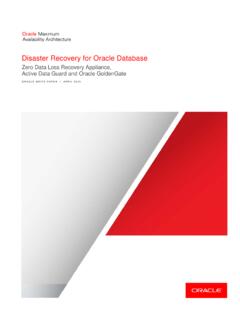Transcription of Hyogo Framework for Action 2005-2015 - Home | UNDRR
1 World Conference on disaster Reduction18-22 January 2005, Kobe, Hyogo , JapanHyogo Framework for Action 2005-2015 :ISDRI nternational Strategyfor disaster ReductionInternational Strategy for disaster the Resilience of Nations and Communities to Disasters**Extract from the final report of the World Conference on disaster Reduction ( ) Contents Paragraphs I. Preamble .. 1 9 A. Challenges posed by disasters .. 2 5 B. The Yokohama Strategy: lessons learned and gaps identified .. 6 9 II. World Conference on disaster Reduction: Objectives, expected outcome and strategic goals .. 10 12 A. Objectives .. 10 B.
2 Expected outcome .. 11 C. Strategic goals .. 12 III. Priorities for Action 2005-2015 .. 13 20 A. General considerations .. 13 B. Priorities for Action .. 14 20 1. Ensure that disaster risk reduction is a national and a local priority with a strong institutional basis for implementation .. 16 2. Identify, assess and monitor disaster risks and enhance early warning .. 17 3. Use knowledge, innovation and education to build a culture of safety and resilience at all levels.
3 18 4. Reduce the underlying risk factors .. 19 5. Strengthen disaster preparedness for effective response at all levels 20 IV. Implementation and follow-up .. 21 34 A. General considerations .. 21 29 B. States .. 30 C. Regional organizations and institutions .. 31 D. International organizations .. 32 E. The International Strategy for disaster Reduction.
4 33 F. Resource mobilization .. 34 Annex Some multilateral developments related to disaster risk reduction .. 20 1 I. Preamble 1. The World Conference on disaster Reduction was held from 18 to 22 January 2005 in Kobe, Hyogo , Japan, and adopted the present Framework for Action 2005-2015 : Building the Resilience of Nations and Communities to Disasters (here after referred to as the Framework for Action ). The Conference provided a unique opportunity to promote a strategic and systematic approach to reducing vulnerabilities1 and risks to It underscored the need for, and identified ways of, building the resilience of nations and communities to A. Challenges posed by disasters 2. disaster loss is on the rise with grave consequences for the survival, dignity and livelihood of individuals, particularly the poor, and hard-won development gains.
5 disaster risk is increasingly of global concern and its impact and actions in one region can have an impact on risks in another, and vice versa. This, compounded by increasing vulnerabilities related to changing demographic, technological and socio-economic conditions, unplanned urbanization, development within high-risk zones, under-development, environmental degradation, climate variability, climate change, geological hazards, competition for scarce resources, and the impact of epidemics such as HIV/AIDS, points to a future where disasters could increasingly threaten the world s economy, and its population and the sustainable development of developing countries. In the past two decades, on average more than 200 million people have been affected every year by disasters. 3. disaster risk arises when hazards interact with physical, social, economic and environmental vulnerabilities.
6 Events of hydrometeorological origin constitute the large majority of disasters. Despite the growing understanding and acceptance of the importance of disaster risk reduction and increased disaster response capacities, disasters and in particular the management and reduction of risk continue to pose a global challenge. 4. There is now international acknowledgement that efforts to reduce disaster risks must be systematically integrated into policies, plans and programmes for sustainable development and poverty reduction, and supported through bilateral, regional and international cooperation, including partnerships. Sustainable development, poverty reduction, good governance and disaster risk reduction are mutually supportive objectives, and in order to meet the challenges ahead, accelerated efforts must be made to build the necessary capacities at the community and national levels to manage and reduce risk.
7 Such 1 Vulnerability is defined as: The conditions determined by physical, social, economic, and environmental factors or processes, which increase the susceptibility of a community to the impact of hazards . UN/ISDR. Geneva 2004. 2 Hazard is defined as: A potentially damaging physical event, phenomenon or human activity that may cause the loss of life or injury, property damage, social and economic disruption or environmental degradation. Hazards can include latent conditions that may represent future threats and can have different origins: natural (geological, hydrometeorological and biological) or induced by human processes (environmental degradation and technological hazards) UN/ISDR. Geneva 2004. 3 The scope of this Framework for Action encompasses disasters caused by hazards of natural origin and related environmental and technological hazards and risks.
8 It thus reflects a holistic and multi-hazard approach to disaster risk management and the relationship, between them which can have a significant impact on social, economic, cultural and environmental systems, as stressed in the Yokohama Strategy (section I, part B, letter I, p. 8). 2 an approach is to be recognized as an important element for the achievement of internationally agreed development goals, including those contained in the Millennium Declaration. 5. The importance of promoting disaster risk reduction efforts on the international and regional levels as well as the national and local levels has been recognized in the past few years in a number of key multilateral frameworks and B. The Yokohama Strategy: lessons learned and gaps identified 6. The Yokohama Strategy for a Safer World: Guidelines for Natural disaster Prevention, Preparedness and Mitigation and its Plan of Action ( Yokohama Strategy ), adopted in 1994, provides landmark guidance on reducing disaster risk and the impacts of disasters.
9 7. The review of progress made in implementing the Yokohama Strategy5 identifies major challenges for the coming years in ensuring more systematic Action to address disaster risks in the context of sustainable development and in building resilience through enhanced national and local capabilities to manage and reduce risk. 8. The review stresses the importance of disaster risk reduction being underpinned by a more pro-active approach to informing, motivating and involving people in all aspects of disaster risk reduction in their own local communities. It also highlights the scarcity of resources allocated specifically from development budgets for the realization of risk reduction objectives, either at the national or the regional level or through international cooperation and financial mechanisms, while noting the significant potential to better exploit existing resources and established practices for more effective disaster risk reduction.
10 9. Specific gaps and challenges are identified in the following five main areas: (a) Governance: organizational, legal and policy frameworks; (b) Risk identification, assessment, monitoring and early warning; (c) Knowledge management and education; (d) Reducing underlying risk factors; (e) Preparedness for effective response and recovery. These are the key areas for developing a relevant Framework for Action for the decade 2005 2015. 4 Some of these frameworks and declarations are listed in the annex to this document. 5 Review of the Yokohama Strategy and Plan of Action for a Safer World ( ). 3 II. World Conference on disaster Reduction: Objectives, expected outcome and strategic goals A. Objectives 10. The World Conference on disaster Reduction was convened by decision of the General Assembly, with five specific objectives:6 (a) To conclude and report on the review of the Yokohama Strategy and its Plan of Action , with a view to updating the guiding Framework on disaster reduction for the twenty-first century; (b) To identify specific activities aimed at ensuring the implementation of relevant provisions of the Johannesburg Plan of Implementation of the World Summit on Sustainable Development on vulnerability, risk assessment and disaster management; (c) To share good practices and lessons learned to further disaster reduction within the context of attaining sustainable development, and to identify gaps and challenges.
